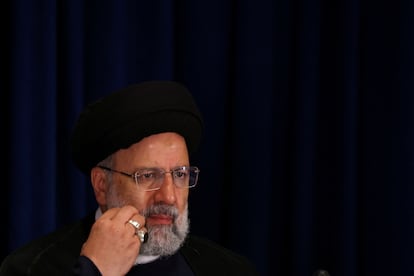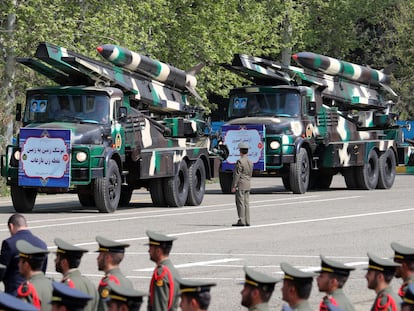Ebrahim Raisi, from ‘hanging judge’ to guardian of the principles of the Islamic Republic of Iran
The president, who died in a helicopter accident, was at one point touted to succeed Supreme Leader Ali Khamenei. He is seen as the embodiment of ultraconservative orthodoxy, a man against change and in favor of repression

The photographs of some of the at least 5,000 political prisoners that Iranian authorities ordered executed in the summer of 1988 look like college graduation snapshots. In the Amnesty International report Blood-soaked secrets, which reviewed the massacres more than 20 years later, the victims are seen as young, twenty-something men and women, while others have even younger faces: they are barely teenagers. These thousands of Iranians were executed and buried in mass graves, after a panel of four followers of the Islamic regime ordered their deaths. According to numerous witnesses, one of those four men was Ebrahim Raisi, 63, who has been president of Iran since 2021, and was found dead on Monday, in a mountainous area near Varzaqan, in the northwest of the country.
The events of that now distant 1988 earned Raisi the reputation of being a “hanging judge.” That moniker never left him. In the eyes of many Iranians, he was considered a man against progress, a guardian of the ultra-conservative orthodoxy of the Iranian Islamic regime, whose greatest exponent is the supreme leader, Ayatollah Ali Khamenei. This camp — known as The Principlists — now controls practically all the levers of power in Iran. Opponents of Western influence in Iran are active in this camp, which advocates for blind obedience to the supreme leader and moving towards an Islamic society that is governed by the theocratic principle of Velayat-e Faqih, or the Guardianship of the Islamic Jurist.
Loyal servant of the regime
The image of the judge — the object of ridicule for his poor eloquence, and who reportedly never completed his studies in law as he claimed — is that of a man who has been a loyal servant of the Islamic regime, which was established in Iran in 1979, when Raisi was 18 years old. Born in Mashhad, about 530 miles east of Tehran, Raisi — who was married with two children — he studied at the Qom Seminary, a religious institution that has produced many hierarchs of the Islamic Republic. His career as a cleric was boosted by his status as a Sayyid, a direct descendant of the Prophet Muhammad.
In Qom, Raisi received classes from several ideologues of the current Iranian regime. In 1981, at the age of 20, he was appointed prosecutor. He had not yet turned 30 when he took part, as deputy prosecutor of Tehran, in the so-called Death Commission that ordered thousands of opponents to be hanged, according to Amnesty International and numerous witnesses. After that, he continued to rise in the ranks. Between 2004 and 2006, he was first deputy head of the judiciary and, between 2014 and 2016, he served as attorney general.
He made another leap forward in 2017, when he ran for president for the first time. Raisi was defeated by the moderate Hassan Rouhani, but, from that moment on, Iran’s power brokers began to prepare for his arrival in the second-highest political office in the country. Meanwhile, in 2019, Raisi was appointed head of the judiciary. Finally, in 2021, the all-powerful Guardian Council — a body fundamentally controlled by the supreme leader — paved his way to the presidency by vetoing 600 candidates in the elections. All of the moderate candidates were ruled out, except one, who also ended up resigning. In the end, only three low-profile candidates competed in the presidential elections, which were tailored to ensure Raisi’s victory.
His win in the June 2021 elections was the culmination of his years of service, but his victory highlighted the weaknesses in the regime. Raisi only received a third of the vote. The turnout, at 48%, was the lowest in the history of the Islamic Republic, which used to record turnout rates of over 70%. Furthermore, almost 13% of those who voted cast a blank vote. This dismal figure in a country where many workers, such as civil servants, are forced to vote, shone a light on the regime’s crisis of legitimacy, especially since Raisi was already being touted as a favorite to succeed the octogenarian supreme leader, Ali Khamenei.
The Ayatollah and Raisi, his right-hand man, confirmed their resistance to a large part of the population’s calls for change, when Mahsa Yina Amini, 22, died in police custody on September 16, 2022, three days after being arrested in Tehran for wearing her veil incorrectly. The demonstrations sparked by Amini’s death were met with a violent repression that the U.N. Independent International Fact-Finding Mission on Iran described as crimes against humanity. According to the U.N. report, at least 550 Iranians died at the hands of paramilitaries and security forces and 60,000 Iranians were detained for taking part in the protests, whose slogan was “Woman, Life, Freedom.” At least nine men were hanged in connection with the protests, one of them in public. When, after these deaths, the protests died down, Raisi no longer appeared to be a favorite to succeed Khamenei.
At the celebrations for the 44th anniversary of the Islamic Republic, on February 11, 2023, Raisi alluded to the demonstrations in a speech, calling them “riots” and boasting of the “defeat of Iran’s enemies.” In the following months, the president announced new measures to impose the veil on the thousands of Iranian women who have taken it off as a sign of civil disobedience following Amini’s death. Many Iranians have not forgotten that Raisi was considered a “hanging judge.” Under his presidency, executions have been ordered at a frenetic pace. In the five months since 2024, Iran has executed at least 226 people, more than one a day, according to the NGO Iran Human Rights. The Iranian regime is also the world’s top executioner of women, with 10 killed so far this year.
On Sunday, after it was announced that Raisi’s helicopter had disappeared, videos of Iranians praying for his life were released. Meanwhile on social media, “jokes and memes” posted by Iranian exiles, and even citizens still inside the country, celebrated the president’s disappearance, explains Spanish-Iranian activist Ryma Sheermohammadi. In a tweet, two exiled Iranian women are seen toasting one another with beer and without veils on the icon of a helicopter. They are the daughters of Minoo Majidi, one of the victims of the violent crackdown on the “Women, Life, Freedom” movement.
Sign up for our weekly newsletter to get more English-language news coverage from EL PAÍS USA Edition









































